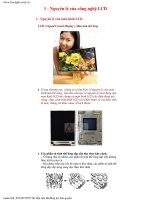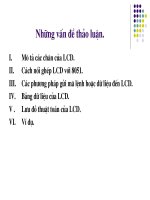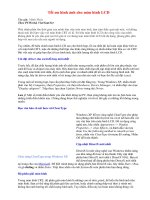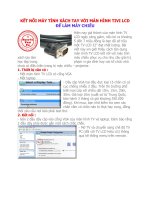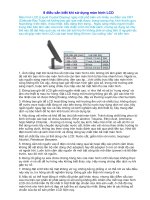LCD
Bạn đang xem bản rút gọn của tài liệu. Xem và tải ngay bản đầy đủ của tài liệu tại đây (165.19 KB, 12 trang )
25. LCD Tool Box
LCD Tool Box
Module
LCD v1.3
Copyright © 2002-2003. Cypress MicroSystems, Inc. All Rights Reserved.
CY8C29/27/24/22xxx and CY8C26/25xxx Data Sheet
PSoC™ Blocks
Resources
Digital
Analog CT
API Memory (Bytes)
Analog SC
CY8C29/27/24/22xxx
Bar Graph Disabled
CY8C26/25xxx
Bar Graph Disabled
Flash
RAM
Pins
622
0
7 from One
Port
442
0
7 from One
Port
622
0
2 7 from One
Port
442
0
7 from One
Port
Features and Overview
• Uses the industry standard Hitachi HD44780 LCD display driver chip protocol
• Requires only seven I/O pins
• Routines provided to print RAM or ROM strings
• Routines provided to print numbers
• Routines provided to display horizontal and vertical bar graphs
• Uses a single I/O port
The LCD Tool Box User Module is a set of library routines that writes text strings and formatted numbers to
a common two- or four-line LCD module. Vertical and horizontal bar graphs are supported, using the
character graphics feature of these LCD modules. This module was developed specifically for the industry
standard Hitachi HD44780 two-line by 16 character LCD display driver chip, but will work for many other
four-line displays. This library uses the 4-bit interface mode to limit the number of I/O pins required.
+5V
Port-X5
Port-X6
Port-X4
Port-X0
Port-X1
Port-X2
Port-X3
1
2
3
4
5
6
7
8
9
10
11
12
13
14
Vss
Vcc
Vee
RS
R/W
E
DB0
DB1
DB2
DB3
DB4
DB5
DB6
DB7
Hitachi HD44780A based
Dot Matrix LCD Module
10K
LCD to PSoC Block Diagram
September 7, 2004
1
User Module Data Sheet
Note
For some displays, it may be good design practice to tie signals DB0-3 on the display to GND with
10K resistors.
Functional Description
The LCD User Module uses a single I/O port to interface to an industry standard Hitachi HD44780A LCD
controller. This type of display has a simple interface consisting of 8 data bits, read/write (R/W), register
select “RS,” and an enable “E” signal. To reduce the number of pins required, the 4-bit interface mode is
used. The LCD to PSoC block diagram and the table below, describe the 4-bit interface connections.
On some displays, DB0, DB1, DB2, and DB3 may need to be pulled down to Vss with a 10K resistor.
Pulling these signals low ensures that the 4-bit mode is entered properly.
LCD to PSoC Interconnect
PSoC Pin
LCD Pin
Description
Port-X0
DB4
Data Bit 0
Port-X1
DB5
Data Bit 1
Port-X2
DB6
Data Bit 2
Port-X3
DB7
Data Bit 3
Port-X4
E
LCD Enable
Port-X5
RS
Register Select
Port-X6
R/W
Read/ Not Write
A cursor position function places the cursor at any location. For two-line by 16 character displays, the
upper left corner is position (0,0) and the lower right corner is position (1,15). (Reference the figure
below.).
Col 0
Col 15
Row 0
Row 1
Cursor Position
Low-level commands are provided to write data to the display Data and Control registers. The LCD
manufacturer’s data sheet should be reviewed for specific features and font information.
2
September 7, 2004
LCD Tool Box
Parameters and Resources
LCDPort
Selects which PSoC I/O port is used to interface to the LCD display module.
Bargraph
Selects whether the bargraph functions are enabled. If disabled, the bargraph code is not generated,
saving ROM space.
Placement
The LCD User Module only uses seven I/O pins of one port and does not use any digital or analog blocks.
There are no placement restrictions. Multiple LCD modules may be placed in a single project.
Application Programming Interface
The Application Programming Interface (API) routines are provided as part of the user module to allow the
designer to deal with the module at a higher level. This section specifies the interface to each function
together with related constants provided by the “include” files.
Note
In this, as in all user module APIs, the values of the A and X register may be altered by calling an
API function. It is the responsibility of the calling function to preserve the values of A and X prior to
the call if those values are required after the call. This “registers are volatile” policy was selected
for efficiency reasons and has been in force since version 1.0 of PSoC Designer. The C compiler
automatically takes care of this requirement. Assembly language programmers must ensure their
code observes the policy, too. Though some user module API function may leave A and X
unchanged, there is no guarantee they will do so in the future.
The following are the API programming routines provided for the LCD User Module.
Basic LCD Tool Box Functions
LCD_Start
Description:
Initializes LCD to use the multi-line 4-bit interface. This function should be called prior to all other LCD
functions.
C Prototype:
void LCD_Start(void);
Assembly:
call LCD_Start
Parameters:
None
Return Value:
None
Side Effects:
The A and X registers may be modified by this or future implementations of this function. The same is
true for all RAM page pointer registers in the Large Memory Model (CY8C29xxx). When necessary, it
is the calling function's responsibility to preserve the values across calls to fastcall16 functions. Currently, only the CUR_PP page pointer register is modified.
September 7, 2004
3
User Module Data Sheet
LCD_Init
Description:
Initializes LCD to use the multi-line, 4-bit interface. This function should be called prior to all other LCD
functions.
C Prototype:
void LCD_Init(void);
Assembly:
call LCD_Init
Parameters:
None
Return Value:
None
Side Effects:
The A and X registers may be modified by this or future implementations of this function. The same is
true for all RAM page pointer registers in the Large Memory Model (CY8C29xxx). When necessary, it
is the calling function's responsibility to preserve the values across calls to fastcall16 functions. Currently, only the CUR_PP page pointer register is modified.
LCD_Position
Description:
Moves cursor to a location specified by the parameters. The upper left character is row 0, column 0.
For a two-line by 16 character display, the lower right character is row 1, column 15.
C Prototype:
void LCD_Position( BYTE bRow, BYTE bCol);
Assembly:
mov
A,01h
; Load Row
mov
X,02h
; Load Column
call LCD_Position
Parameters:
bRow: The row number at which to position the cursor. Zero specifies the first row.
bCol: The column number at which to position the cursor. Zero specifies the first (left most) column.
Return Value:
None
Side Effects:
The A and X registers may be modified by this or future implementations of this function. The same is
true for all RAM page pointer registers in the Large Memory Model (CY8C29xxx). When necessary, it
is the calling function's responsibility to preserve the values across calls to fastcall16 functions. Currently, only the CUR_PP page pointer register is modified.
String Printing Functions
LCD_PrString
Description:
Prints a null terminated RAM-based character string to the LCD at the present cursor location.
4
September 7, 2004
LCD Tool Box
C Prototype:
void LCD_PrString(CHAR * sRamString);
Assembly:
mov
A,>sRamString
; Load MSB part of pointer to RAM-based null
; terminated string.
mov
X,
; terminated string.
call LCD_PrString
; Call function to display string at current
; LCD cursor position.
Parameters:
sRamString: A pointer to a null-terminated string located in RAM.
Return Value:
None
Side Effects:
The A and X registers may be modified by this or future implementations of this function. The same is
true for all RAM page pointer registers in the Large Memory Model (CY8C29xxx). When necessary, it
is the calling function's responsibility to preserve the values across calls to fastcall16 functions. Currently, the CUR_PP and IDX_PP page pointer registers are modified.
LCD_PrCString
Description:
Prints a null terminated ROM-based character string to the LCD at the present cursor location.
C Prototype:
void LCD_PrCString(const char * sRomString);
Assembly:
mov
A,>sRomString
; Load MSB part of pointer to ROM-based null
; terminated string.
mov
X,
; terminated string.
call LCD_PrCString
; Call function to display string at current
; LCD cursor position.
Example String Printing Code:
char str[ ] = "User Module";
// Define "RAM" based string
LCD_Start();
// Initialize LCD hardware
LCD_Position(0,4);
// Position cursor @ row 0, col 4
LCD_PrCString("PsoC LCD");
// Print a constant "ROM" string
LCD_Position(1,2);
// Position cursor @ row 1, col 2
LCD_PrString(str);
// Print "RAM" based string.
Example Text Display
Parameters:
sRomString: A pointer to a null-terminated string located in ROM.
Return Value:
None
September 7, 2004
5
User Module Data Sheet
Side Effects:
The A and X registers may be modified by this or future implementations of this function. The same is
true for all RAM page pointer registers in the Large Memory Model (CY8C29xxx). When necessary, it
is the calling function's responsibility to preserve the values across calls to fastcall16 functions. Currently, only the CUR_PP page pointer register is modified.
Number Printing Functions
LCD_PrHexByte
Description:
Prints a byte as a two-character hex string at the present LCD cursor position.
C Prototype:
void LCD_PrHexByte(BYTE bValue);
Assembly:
mov
A, [bValue]
; Load byte to be printed
call LCD_PrHexByte
; Call function
Parameters:
bValue: An 8-bit value to display as a two-character hex string.
Return Value:
None
Side Effects:
The A and X registers may be modified by this or future implementations of this function. The same is
true for all RAM page pointer registers in the Large Memory Model (CY8C29xxx). When necessary, it
is the calling function's responsibility to preserve the values across calls to fastcall16 functions. Currently, only the CUR_PP page pointer register is modified.
LCD_PrHexInt
Description:
Prints an integer as a four-character hex string at the present LCD cursor position.
C Prototype:
void LCD_PrHexInt(INT iValue);
Assembly:
mov
A, [iValue+1]
; Load LSB byte to be printed
mov
X, [iValue]
; Load MSB byte to be printed
call LCD_PrHexInt
; Call function
Parameters:
iValue: A 16-bit value to display as a four-character hex string.
Return Value:
None
Side Effects:
The A and X registers may be modified by this or future implementations of this function. The same is
true for all RAM page pointer registers in the Large Memory Model (CY8C29xxx). When necessary, it
is the calling function's responsibility to preserve the values across calls to fastcall16 functions. Currently, only the CUR_PP page pointer register is modified.
6
September 7, 2004
LCD Tool Box
Horizontal Bar Graph Functions
Each display character consists of five horizontal pixels by eight vertical pixels. Horizontal bar graphs
display a set of vertical lines that are each composed of one horizontal pixel by eight vertical pixels, within
a single character – a pixel column. Each character can display one to five vertical pixel columns, where
five pixel columns display the entire character.
Starting on the left side of the display, the first pixel column is numbered 1 and the last pixel column is
numbered N * 5, where N is the number of characters. A 16-character display has 80 possible pixel
columns numbered 1 to 80.
Solid bar graphs display 1 to N pixel columns, within a set of specified continuous characters. Line bar
graphs display only the specified pixel column. Below is an example of both types of horizontal bar
graphs.
Solid Horizontal Bar Graph
Line Horizontal Bar Graph
Bar Graph Types
LCD_InitBG
Description:
Initializes the LCD to display the specified type of horizontal bar graph. This function should be called
prior to calling LCD_DrawBG(). The type of bar graph must be specified. This function does not draw
a bar graph, but loads the custom character RAM with the data required to display the specified type
of bar graph. This routine must be called to change between horizontal bar-graph types.
LCD_SOLID and LCD_LINE are defined as input constants.
C Prototype:
void LCD_InitBG(BYTE bBGType);
Assembly:
mov
A, LCD_SOLID_BG
call LCD_InitBG
Parameters:
BYTE bBGType: Type of bar graph specified as one of the following:
LCD_SOLID_BG
LCD_LINE_BG
Return Value:
None
Side Effects:
The A and X registers may be modified by this or future implementations of this function. The same is
true for all RAM page pointer registers in the Large Memory Model (CY8C29xxx). When necessary, it
is the calling function's responsibility to preserve the values across calls to fastcall16 functions. Currently, only the CUR_PP page pointer register is modified.
September 7, 2004
7
User Module Data Sheet
LCD_DrawBG
Description:
Draws the horizontal bar graph starting at character location (bRow,bCol) with a character length of
“bLen” to column position of “bPixelColEnd”.
C Prototype:
void LCD_DrawBG(BYTE bRow, BYTE bCol, BYTE bLen, BYTE bPixelColEnd);
Assembly:
mov
A,25h
; Set bPixelColEnd = 25
push A
mov
A,06h
; Set bLen = 6 pixel columns
push A
mov
A,03h
; Set bCol = 3
push A
mov
X,SP
; Setup data pointer (X)
dec
X
mov
A,01h
; Set bRow = 1 -> the second line
call LCD_DrawBG
add
SP,-3
; Restore the stack
Parameters:
bRow: Defines the starting character row – range of 0 to number of rows minus1.
bCol: Defines the starting character column – range of 0 to number of character columns minus 1.
bLen: Defines the length of the bargraph in whole characters.
bPixelColEnd: Defines at which pixel column to draw the following.
Note
Solid bar graphs draw all the pixel columns from the first pixel column of the character defined by
bRow and bCol to the pixel column specified by bPixelColEnd. Line bar graphs draw the specific
pixel column specified in the define character.
For line bargraphs bLen=1 and bPixelColEnd is in the range of 1 to 5.
LCD_DrawBG(0, 0, 16, 72);
LCD_DrawBG(1, 3, 10, 32);
Examples of Horizontal Bar Graphs
Return Value:
None
Side Effects:
The A and X registers may be modified by this or future implementations of this function. The same is
true for all RAM page pointer registers in the Large Memory Model (CY8C29xxx). When necessary, it
is the calling function's responsibility to preserve the values across calls to fastcall16 functions. Currently, only the CUR_PP page pointer register is modified.
8
September 7, 2004
LCD Tool Box
Vertical Bar Graph Functions
Each display character consists of five horizontal pixels by eight vertical pixels. Vertical bar graphs
display a set of horizontal lines that are each composed of one vertical pixel by five horizontal pixels,
within a single character – a pixel row. Each character can display one to eight horizontal pixel rows,
where eight pixel rows display the entire character.
Starting on the bottom of a character, the first pixel row is numbered 1 and the last pixel row is numbered
8. Combining two rows can generate a vertical bar graph of 16 pixel rows.
LCD_InitVBG
Description:
Initializes the LCD to display vertical bar graphs. This should be called prior to calling
LCD_DrawVGB(). This function initializes the custom character RAM with the data required to draw
vertical bar graphs.
C Prototype:
void LCD_InitVBG(void);
Assembly:
call LCD_InitVBG
Parameters:
None
Return Value:
None
Side Effects:
The A and X registers may be modified by this or future implementations of this function. The same is
true for all RAM page pointer registers in the Large Memory Model (CY8C29xxx). When necessary, it
is the calling function's responsibility to preserve the values across calls to fastcall16 functions. Currently, only the CUR_PP page pointer register is modified.
LCD_DrawVBG
Description:
Draws a vertical bar graph starting from the first pixel row at character location (bRow, bCol), with a
character height of bHeight, up to the specified vertical pixel row bPixelRowEnd.
C Prototype:
void LCD_DrawVBG(BYTE bRow, BYTE bCol, BYTE bHeight, BYTE bPixelRowEnd);
Assembly:
call LCD_DrawVBG
Parameters:
bRow: Defines the starting character row – range of 0 to number of rows minus 1.
bCol: Defines the starting character column – range 0 to number of character columns minus 1.
bHeight: Defines the height of the vertical bargraph in whole characters.
bPixelRowEnd: Defines at which vertical pixel row to draw to.
September 7, 2004
9
User Module Data Sheet
LCD_DrawVBG(1, 5, 2, 16);
LCD_DrawVBG(1, 3, 2, 12);
LCD_DrawVBG(1, 1, 2, 5);
Examples of Vertical Bar Graphs
Return Value:
None
Side Effects:
The A and X registers may be modified by this or future implementations of this function. The same is
true for all RAM page pointer registers in the Large Memory Model (CY8C29xxx). When necessary, it
is the calling function's responsibility to preserve the values across calls to fastcall16 functions. Currently, only the CUR_PP page pointer register is modified.
Optional Functions
LCD_Control
Description:
Writes a byte to the LCD Control register. Review the specific LCD data sheet for specific LCD valid
commands.
C Prototype:
void LCD_Control(BYTE bCmd);
Assembly:
mov
A,03h
; Load data to be written to Control register.
call LCD_Control
; Call function
Parameters:
bCmd: Byte value to send to the Control register.
Return Value:
None
Side Effects:
The A and X registers may be modified by this or future implementations of this function. The same is
true for all RAM page pointer registers in the Large Memory Model (CY8C29xxx). When necessary, it
is the calling function's responsibility to preserve the values across calls to fastcall16 functions. Currently, only the CUR_PP page pointer register is modified.
LCD_WriteData
Description:
Writes a byte or character to the LCD Data register.
C Prototype:
void LCD_WriteData(BYTE bData);
Assembly:
mov
A,03h
; Load data to be written to Data register
10
September 7, 2004
LCD Tool Box
call LCD_WriteData
; Call function
Parameters:
bData: Byte value to send to the Data register.
Return Value:
None
Side Effects:
The A and X registers may be modified by this or future implementations of this function. The same is
true for all RAM page pointer registers in the Large Memory Model (CY8C29xxx). When necessary, it
is the calling function's responsibility to preserve the values across calls to fastcall16 functions. Currently, only the CUR_PP page pointer register is modified.
LCD_Delay50uTimes
Description:
Delays for “bTimes” multiples of 50 µs. This delay loop is CPU clock independent.
C Prototype:
void LCD_Delay50uTimes(BYTE bTimes);
Assembly:
mov
A,03h
; Load delay time (example 3 would be 150uSec).
Call LCD_Delay50uTimes ; Call function
Parameters:
bTimes: Number of times to delay 50 µSec.
Return Value:
None
Side Effects:
The A and X registers may be modified by this or future implementations of this function. The same is
true for all RAM page pointer registers in the Large Memory Model (CY8C29xxx). When necessary, it
is the calling function's responsibility to preserve the values across calls to fastcall16 functions.
LCD_Delay50u
Description:
Delays for 50 µs. This funtion is clock independent.
C Prototype:
void LCD_Delay50u(void);
Assembly:
call LCD_Delay50u
; Call function
Parameters:
None
Return Value:
None
Side Effects:
The A and X registers may be modified by this or future implementations of this function. The same is
true for all RAM page pointer registers in the Large Memory Model (CY8C29xxx). When necessary, it
is the calling function's responsibility to preserve the values across calls to fastcall16 functions.
September 7, 2004
11
User Module Data Sheet
Sample Firmware Source Code
The following is a simple assembly and C example for printing a string on the LCD.
;;----------------------------------------------------------------;; Sample asm LCD Code
;;
;; Print the string “PSoC LCD” on the top row starting at the 6th
;; location on an LCD.
;;----------------------------------------------------------------include "m8c.inc"
include "PSoCAPI.inc"
export _main
; part specific constants and macros
; PSoC API definitions for all User Modules
area text (ROM, REL)
_main:
call
mov
mov
call
mov
mov
call
LCD_Start
A,00h
X,05h
LCD_Position
A,>THE_STR
X,
loop:
jmp
loop
.LITERAL
THE_STR:
DS "PSoC LCD"
DB 00h
.ENDLITERAL
; Initialize LCD
; Set cursor postion at row = 0
; col = 5
; Load pointer to ROM string
; Print constant "ROM" string
; String should always be null terminated
A sample project written in C is as follows.
//-------------------------------------------------------------------// Sample C code for LCD
//
// Print the string “PSoC LCD” on the top row starting at the 6th
// location on an LCD.
//
//-------------------------------------------------------------------#include <m8c.h>
// part specific constants and macros
#include "PSoCAPI.h"
// PSoC API definitions for all User Modules
void main()
{
char theStr[] = "PSoC LCD";
// Define RAM string
LCD_Start();
// Initialize LCD
LCD_Position(0,5);
// Place LCD cursor at row 0, col 5.
LCD_PrString(theStr);
// Print "PSoC LCD" on the LCD
}
12
September 7, 2004

